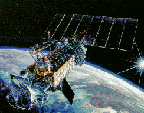|
|
Gamma-ray Astronomy Satellites & Missions
We present the many satellites which have detected electromagnetic radiation
with energy greater than 100 keV by the decade in which the satellite was
launched. You will see, as you go through the 1960s, 70s, 80s, and 90s, that
the sensitivity increase in the detectors has developed greatly during the
over 30 years of gamma-ray astronomy. In addition, our ability to localize the incident gamma-rays has developed enormously -- allowing us to obtain
high-quality images of many fascinating celestial objects.
NOTE: We include here only missions which detected non-solar gamma-rays
(intentionally or not).

OSO 3
(Credit: NASA)
|
1960s
The first dedicated
gamma-ray
astronomy mission was, in fact, the first high-energy
astrophysics
satellite as well. Explorer-XI was launched in 1961. The instrument package
weighed 30 pounds, was 20 inches high and 10 inches in diameter. The
experimenters believed that they detected 22 cosmic gamma rays.
Their next detector, on Orbiting Solar Observatory -3, may be more accurately
described as having proof of the discovery of cosmic gamma radiation, since
it found a galactic plane anisotropy of high-energy gammas, much later to be
confirmed with SAS-2 and COS-B. However, a totally unexpected but very
important contributor to the origins of gamma ray astronomy in the 1960s and
1970s were the Vela satellites.
Intended to watch for countries violating an international treaty banning atmospheric
testing of nuclear weapons, they instead gave us the first hints at the odd
phenomena of gamma-ray bursts.

COS B
(Credit: NASA)
|
1970s
The SAS-2 satellite in 1972 discovered a diffuse gamma-ray background, and
the COS-B (1975 - 1982) satellite produced the first detailed map of the sky
at gamma-ray
wavelengths. A
number of pulsars
were discovered to also emit pulses
at these wavelengths. The gamma-ray sky was found to be dominated by diffuse
emission from the galactic plane, which at the highest energies
(E > 100 MeV) is the decay of neutral pions generated in the collision of
cosmic rays with interstellar gas.

DMSP
(Credit: NASA)
|
1980s
The decade of the 1980s saw a few missions occur which continued to gather
data on gamma-ray burst distributions in the sky, gamma-ray emission from known
X-ray sources, and
so on. Much of this decade, however, went into the development of new
technologies, technologies that would be needed to take gamma-ray astronomy to
the next level of
sensitivity
and understanding.

CGRO
(Credit: NASA)
|
1990s
With the launch of the
Compton Gamma-Ray Observatory (CGRO) in April 1991, the
field of gamma-ray astronomy at long last had its flagship. The satellite
carried four major experiments which greatly improved the spatial and
temporal resolution of gamma-ray observations. The CGRO ceased
operation in June 2000, and was de-orbited by NASA. However,
scientists are still studying its data to improve
our understanding of the high-energy processes in our Universe.

INTEGRAL
(Credit: NASA)
|
2000s
The initial years of the 21st century see the a new fleet of
gamma-ray instruments and observatories. With the result from
Beppo-SAX and other observatories that gamma-ray bursts are at
extra-galactic distances, Swift was poised to determine the nature
of GRBs by performing rapid follow-up observations in X-ray and UV
wavelengths. GLAST, set for launch in mid-decade, promises to be the
premier gamma-ray observatory into the next decade.
|
